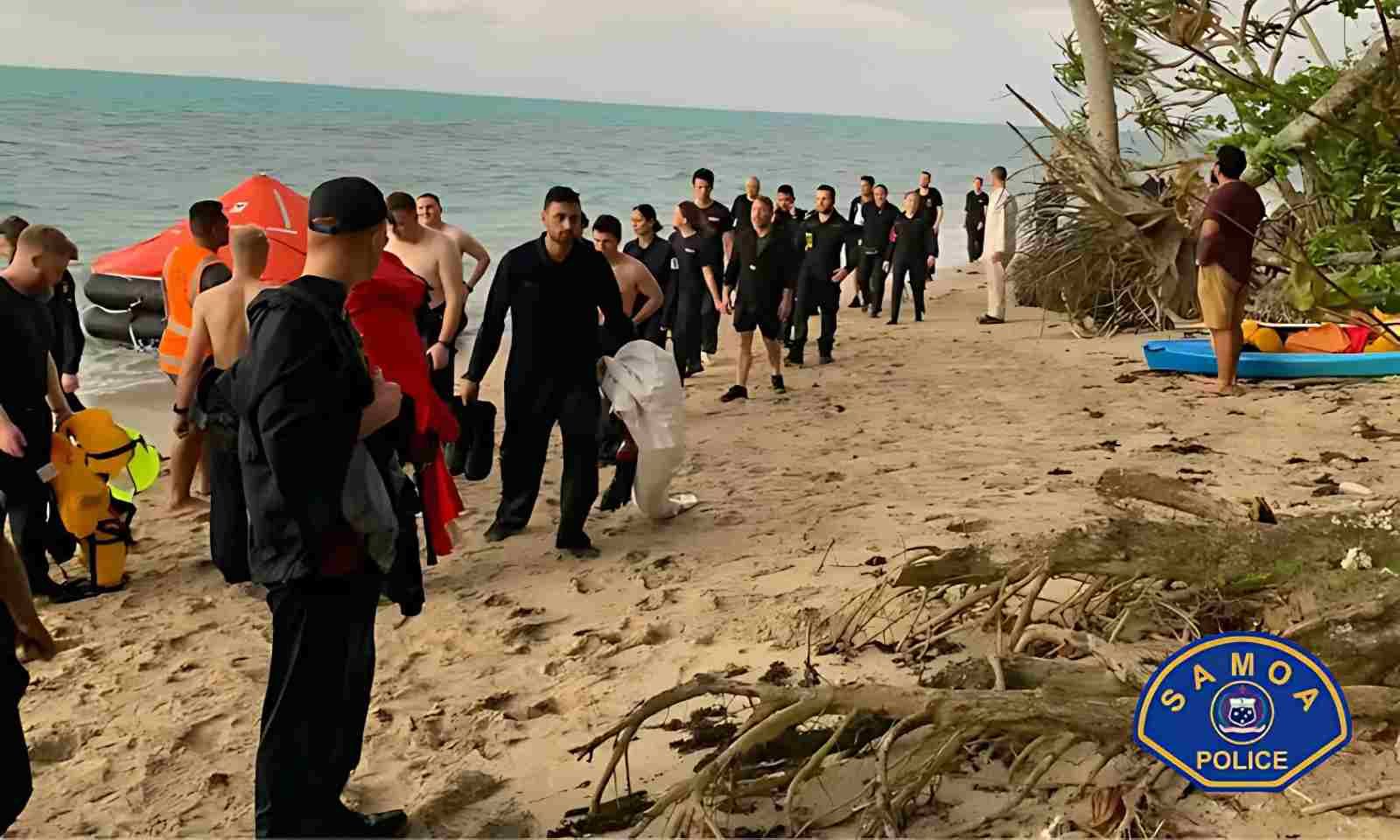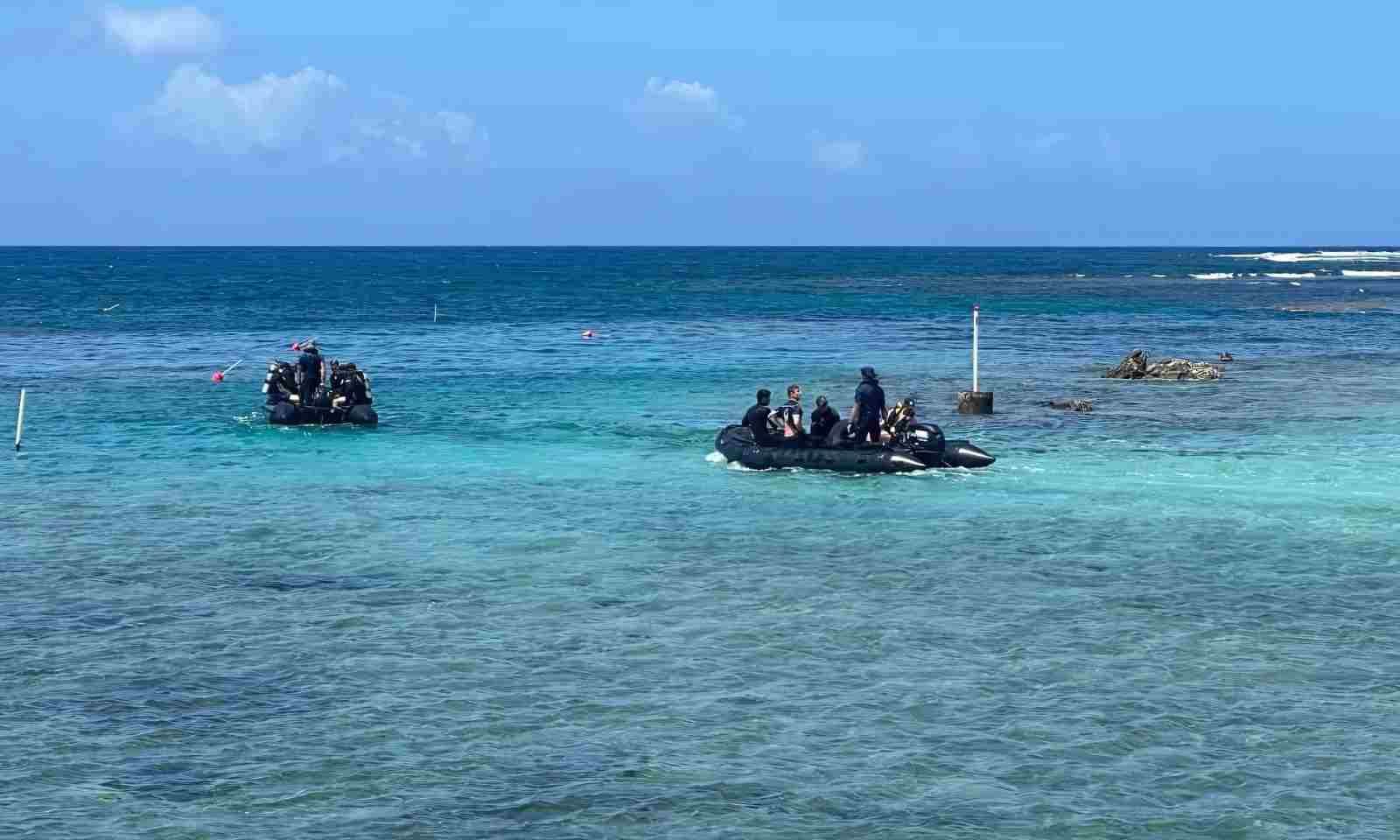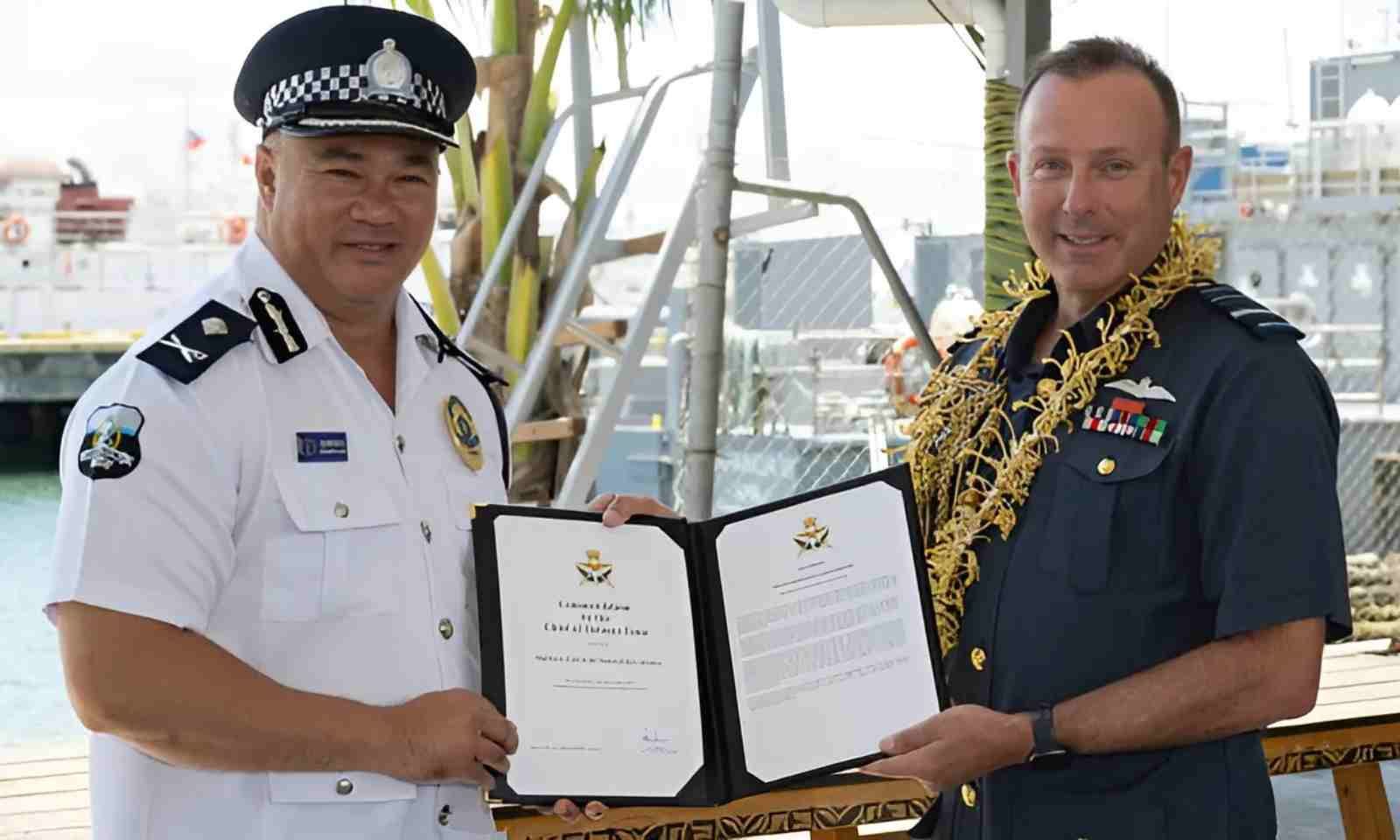

Shalom Tapusalaia receives the award for the crew of the Double Down from NZ's Chief of Defence Force, Air Marshal Tony Davies.
Photo/NZDF
HMNZS Manawanui: Sāmoa's first responders honoured
A report on the ship's sinking has been received by NZ's Defence Force as it closes in on removing fuel from the stricken naval vessel.


Christmas under the sun: How Pasifika are celebrating amid rising heat, extreme weather




Christmas under the sun: How Pasifika are celebrating amid rising heat, extreme weather


The head of New Zealand's Defence Forces has awarded high-level commendations to first responders to the grounding and sinking of HMNZS Manawanui in Sāmoa last month.
On 5 October, the vessel hit a reef while conducting a hydrographic survey off the southern coast of Upolu Island. All 75 passengers and crew were rescued.

Those who were commended for their efforts to help rescue the passengers and crew of the HMNZS Manawanui. Photo/NZDF
The NZDF says fuel removal from the sunken naval vessel will begin next month.
In its latest update, the NZDF said its contract with the salvage company was nearly completed.
The defence force has engaged Pacific 7 Limited and Bay Underwater Services NZ Ltd to safely remove, recover, and dispose of fuel and other pollutants on board the vessel.
It also said that the Manawanui's main fuel tanks remained intact.
"Once the fuel removal contract has been finalised, the salvor will be mobilising equipment and personnel to Sāmoa to remove the fuel and other pollutants from the ship," Commodore Andrew Brown said.
Brown said the Sāmoan authorities had signed off on the methodology.
Navy chief Rear-Admiral Garin Golding has received the interim Court of Inquiry report into the sinking of the Manawanui.
Golding said the court had made good progress with its investigations and was on track with interviews and evidence gathering.
“I will now take the time required to review the interim report to gain an understanding of what the findings are at this point in proceedings.”
The interim report will focus on what happened, while the final report will provide a fuller context of why the incident occurred and the lessons to be learned.

All 75 passengers and crew of the Manawanui were rescued. Photo/Samoa Fire and Emergency Services Authority via Facebook
“The interim report will also undergo an independent King’s Counsel legal review, and following that, we will look to release to the public later this month some of the key information about what happened.”
Chief of Defence Force (CDF) Air Marshal Tony Davies presented four commendations at a ceremony in Apia last week to a Sāmoan tour guide who paddled out to the ship in his kayak, the crew of one of the first vessels on the scene, a Royal Australian Navy officer who helped coordinate the rescue operation, and the Sāmoan Maritime Police.
CDF honours are usually presented to past or present NZDF personnel who "go above and beyond" what is expected of them.
“I wish to convey my appreciation to all those involved in the response to the sinking of HMNZS Manawanui," he said.
"We have awarded commendations to recognise the many and varied contributions made by numerous people in the immediate response.
"These efforts are very much appreciated, and I would like to thank everyone on behalf of the New Zealand Defence Force.”

Commendation goes to local fisherman Lui Nifo, who paddled his canoe to rescue some of the crew in the sinking Manawanui. Looking on is CDF chief, Air Marshal Tony Davies. Photo/NZDF
Australian Defence Force (ADF) Maritime Security Adviser Lieutenant-Commander Jared Willans was posted to Sāmoa before HMNZS Manawanui struck the reef on 5 October.
“His local knowledge and maritime expertise provided critical situational awareness as weather and sea conditions deteriorated throughout the evening and into the following day,” Davies said.
Local fisherman Lui Nifo took his kayak out. He towed another kayak to where the Manawanui had run aground, assisting rescue operations in rapidly deteriorating weather conditions to locate, guide, and evacuate the ship's 75 passengers and crew.
Nifo also rescued the first crew to reach the shore in Sa’anapu-tai Village and relayed to responders on the beach the locations of the remaining crew members in the water. Another person used the second kayak to reach the shore.
“His courage and determined efforts, in an extremely complex and deteriorating environment, were a major factor in the entire crew of Manawanui being safely rescued,” Davies said.
The Air Marshal chief also commended Doug Ahnne, captain of the vessel Double Down, and his crew, who Davies said was instrumental in the rescue operations after Willans contacted them.

Divers at the site of the stricken vessel. Photo/supplied
"The Double Down responded immediately and assisted with rescue operations throughout the evening by transferring the Manawanui crew from life rafts to the cable ship MS Lodbrog.
"When conditions worsened, Double Down took a further 10 sailors from the life rafts and waited out conditions in a sheltered bay until daylight, and it was safe to take them ashore.
“The courage and efforts of the captain and crew of the Double Down in the rescue of Manawanui’s crew during very challenging conditions are a credit to themselves, and they are worthy recipients of a New Zealand Chief of Defence Force commendation,” Davies said.
Shalom Tapusalaia, who was on the Double Down that night, received the commendation.
The Maritime Unit of the Sāmoan Police Service was honoured for mobilising its vessels, including small craft and patrol boat Nafanua III.
Manawanui crew members were safely transferred to many smaller vessels, and Nafanua III rescued 18 sailors in deteriorating conditions of rough seas and high winds.
Davies also made three presentations to others involved in the rescue operation - Sāmoa Fire and Emergency Service Authority, the captain and crew of the French vessel, MS Lodbrog, and the New Zealand High Commission staff in Apia.
Fire and Emergency staff led the maritime-based rescue operations, managing and organising multiple small vessels in complex and deteriorating conditions.
The captain of the MS Lodbrog, Master Augustin Vandenhove, responded to the emergency call and maneuvered his ship to a leeward position to provide shelter from the high winds and rough seas.
Davies said this allowed the smaller vessels to transfer the rescued members aboard the Lodbrog.
“This demonstration of maritime skills in answering the distress call at sea is held in the highest of regards,” Davies said.
Since the Manawanui's sinking, concerns about the vessel's environmental impact have been raised. Operation Resolution, the cleanup effort, primarily focuses on fuel tanks.

Staff from the Ministry of Works in Samoa carry out shoreline monitoring of the impact of the wreck of the Manawanui. Photo/Ministry of Works Transport and Infrastructure, Samoa
Three shipping containers from the Manawanui were removed from the coral reef last month. Residents have reported an oil-like substance and rubbish in the water around the wreck.
Local conservationists have also called for their removal to preserve the ecosystem. They say the reef where the Manawanui struck is well known for its large population of sea turtles, which come to feed in the area.
"They will likely sense the pollution and eventually stay away, as will pelagic fish," one advocate told journalists.
"Given the area is the local villagers’ food basket and a tourist destination, any harmful effects on the coastal environment and coral reefs will be keenly felt."
Residents on the southwest coast of Upolu have been warned not to eat fish from the area. The Sāmoan government wants financial compensation from Wellington.
The New Zealand High Commission in Apia says its staff have supported the salvage crews and cleanup operations.
NZDF says HMNZS Manawanui was the Royal New Zealand Navy's specialist dive and hydrographic vessel - the fourth ship to carry that name. It allowed the Navy to conduct a range of specialist diving, salvage, and hydrography tasks around New Zealand and the South West Pacific.

Acting Police Commissioner Lafaitele Herbert Aati accepts the commendation for the Sāmoan police from NZ's Chief of Defence Force, Air Marshal Tony Davies. Photo/NZDF